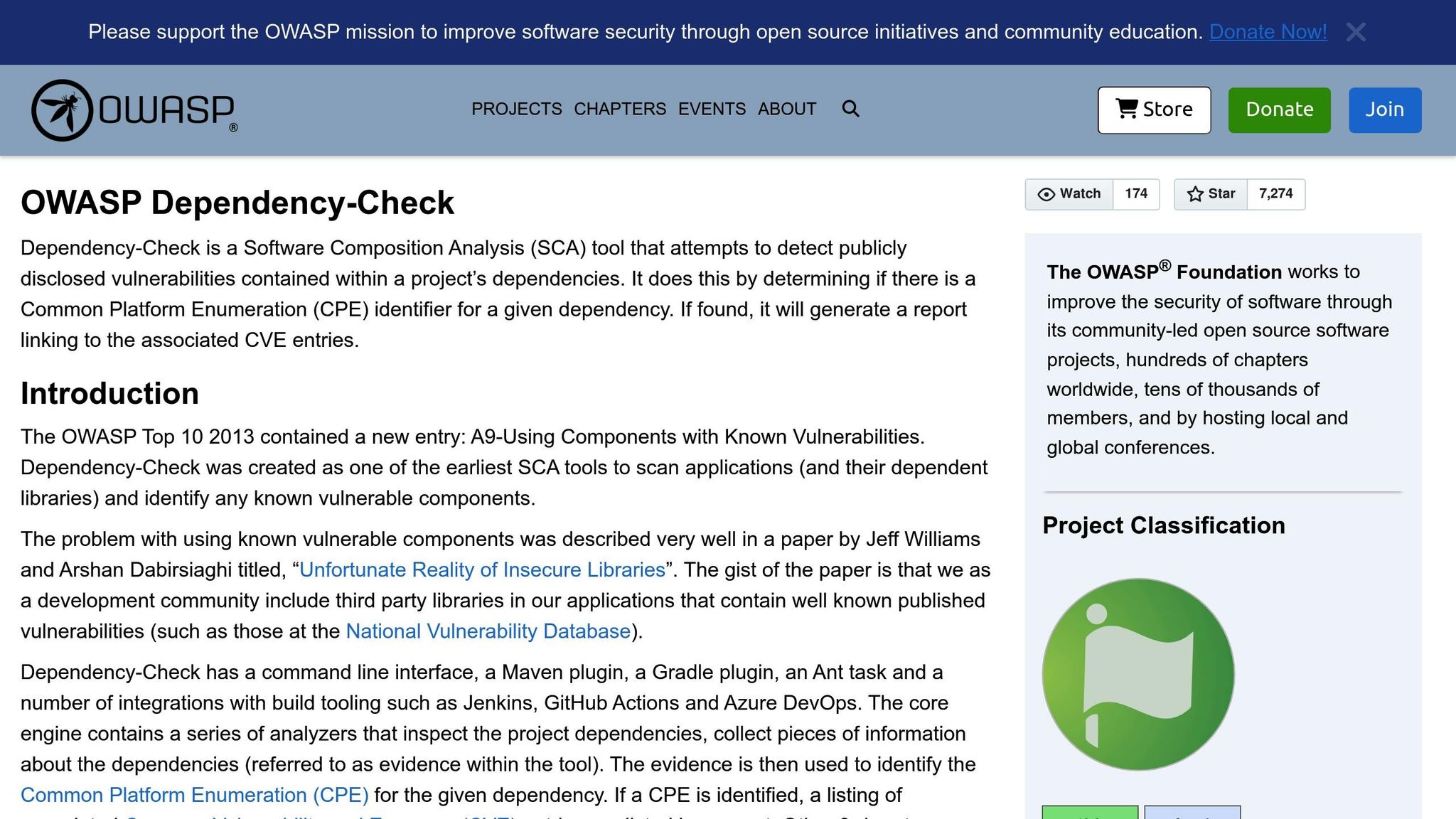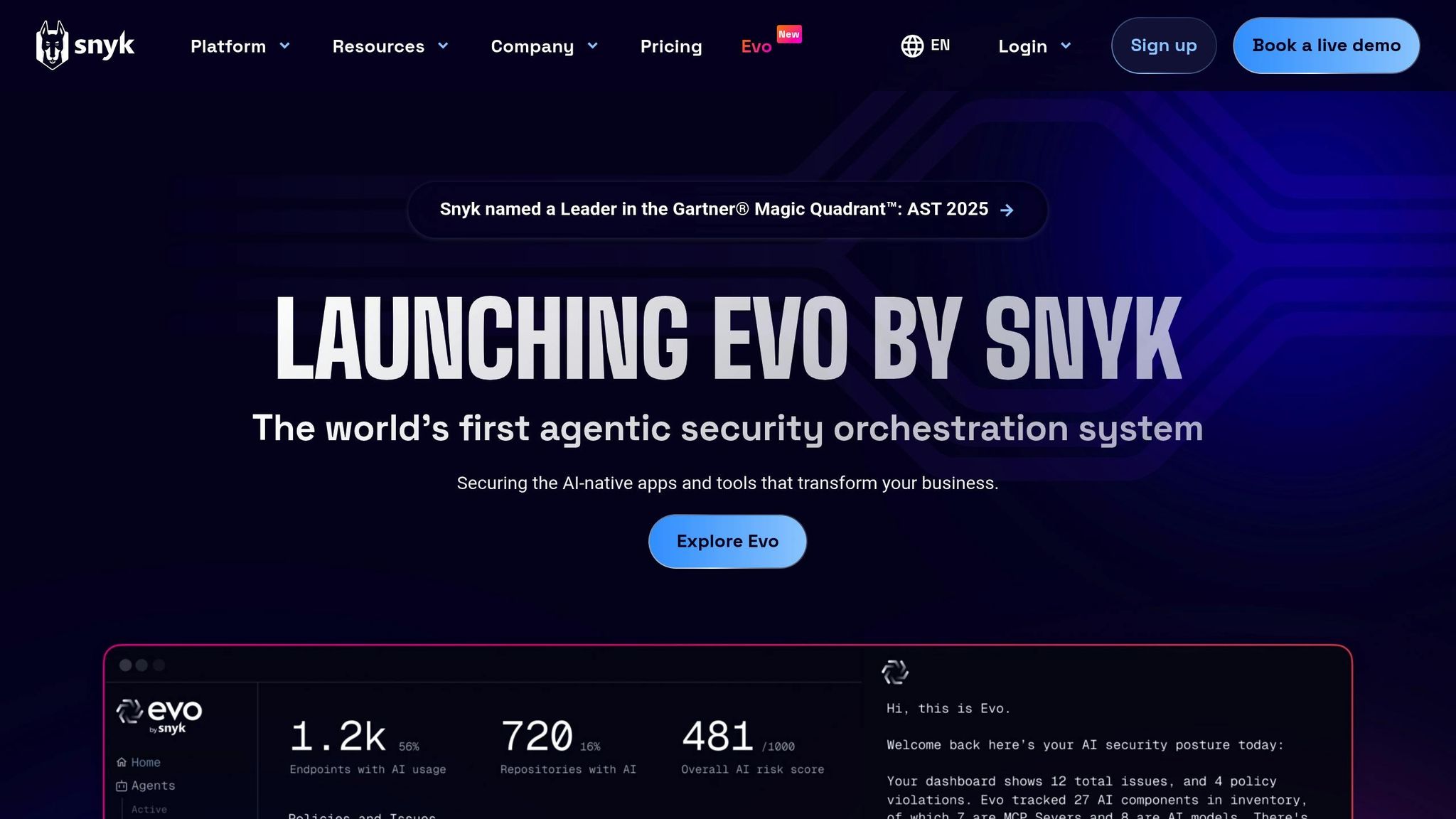Dependency scanning is a critical step in securing software development workflows. It identifies vulnerabilities, licence issues, and outdated components in third-party libraries, ensuring your applications remain secure and compliant. With 80% of applications relying on open-source code, and 65% of vulnerabilities linked to these dependencies, automated tools integrated into CI/CD pipelines can drastically reduce risks.
Here’s a quick look at some leading tools:
- OWASP Dependency-Check: Free, open-source, multi-language support, ideal for small projects.
- Mend: Continuous scanning and compliance features, suited for large enterprises.
- Snyk: Developer-friendly with actionable fixes, flexible for teams of all sizes.
- Checkmarx: Comprehensive security testing, great for regulated industries.
- Anchore: Specialised in container security and SBOM generation.
Each tool offers unique benefits, from real-time alerts to compliance reporting, helping UK organisations meet standards like GDPR and ISO/IEC 27001. Automated scanning not only reduces detection and remediation time but also prevents costly security incidents. Choosing the right tool depends on your workflow, tech stack, and compliance needs.
Secure Apps with Automated Dependency Scans in GitLab CI

Key Features of Dependency Scanning Tools
When choosing a dependency scanning tool for your CI/CD pipeline, the right features can transform your security process from a manual headache into a streamlined, automated solution. UK businesses, in particular, need tools that identify vulnerabilities, fit seamlessly into development workflows, and comply with local regulations.
CI/CD Platform Integration
A tool that integrates smoothly with your existing CI/CD setup is a must-have. The best options offer native plugins for platforms like Jenkins, GitHub Actions, GitLab, and Azure DevOps. For example, OWASP Dependency-Check works with Maven and Gradle in Jenkins, while Snyk uses GitHub Actions to provide real-time alerts directly in pull requests. Tools like Mend go a step further by automatically scanning every code commit and pull request, ensuring continuous monitoring and quick detection of vulnerabilities.
For UK teams managing diverse tech stacks, multi-language support is another critical feature. OWASP Dependency-Check, for instance, supports Java, .NET, Python, Ruby, and Node.js, making it a versatile choice for most development environments.
Vulnerability Detection and Fixes
The effectiveness of a dependency scanning tool lies in its ability to accurately detect vulnerabilities and provide actionable fixes. These tools typically use software composition analysis to compare dependencies against databases like CVE and the NVD. Advanced tools minimise false positives and uncover even obscure vulnerabilities.
What sets premium tools apart is their ability to offer tailored remediation advice. Instead of just flagging issues, they explain the potential impact and recommend specific fixes, such as upgrades, patches, or configuration changes, all within the developer's workflow. While open-source options like OWASP Dependency-Check provide a strong foundation, they may occasionally miss less common vulnerabilities or generate false positives, requiring manual intervention. Premium tools, on the other hand, help teams prioritise fixes based on real-world risk rather than theoretical severity.
Compliance and Reporting Features
For businesses in the UK operating under strict regulations, compliance and reporting features are non-negotiable. Modern scanning tools include licence compliance checks, audit logs, and the ability to generate a Software Bill of Materials (SBOM) to meet increasing regulatory demands.
Licence compliance checks automatically flag dependencies with risky or incompatible licences, helping organisations steer clear of legal trouble. Tools like Mend and Anchore excel here, offering detailed reports and identifying problematic licences before they become an issue. Audit logs, meanwhile, create a clear record of scans, findings, and remediation actions - essential for both internal governance and external audits. This is particularly valuable for meeting requirements under frameworks like GDPR, ISO/IEC 27001, or the NIS2 Directive.
SBOM generation is another growing priority, reflecting evolving UK and EU demands for transparency in the software supply chain. Tools such as Anchore can automatically produce detailed SBOMs that list all components in a software release, providing the visibility regulators increasingly require. For tools without built-in SBOM capabilities, OWASP Dependency-Check can be paired with CycloneDX for automated SBOM creation.
According to PeerSpot reviews, Mend and Checkmarx are among the highest-rated tools for CI/CD security integration. Mend is particularly appreciated for its user-friendly design and robust compliance reporting[3].
These features not only help businesses meet regulatory requirements but also set the stage for evaluating tool capabilities in greater detail in the next section.
Best Dependency Scanning Tools for CI/CD Pipelines
When it comes to securing your CI/CD pipelines, the choice of dependency scanning tools can range from free, open-source options to enterprise-grade platforms. These tools cater to various organisational needs, balancing factors like cost, scalability, and specific security goals. Below, we've outlined some of the top tools available, including their strengths, pricing, and ideal use cases.
OWASP Dependency-Check

OWASP Dependency-Check is a free, open-source tool designed to scan project dependencies against CVE databases. It integrates seamlessly with popular tools like Maven, Gradle, and Jenkins, and supports a wide range of programming languages, including Java, .NET, Python, Ruby, and Node.js. Its straightforward setup makes it a solid choice for small to medium-sized projects. However, it can sometimes generate false positives and features a basic dashboard, which might not meet the demands of large enterprise environments.
Pricing: Free and open source.
Mend (formerly WhiteSource)

Mend takes dependency scanning to the next level by offering continuous security monitoring. It checks every code commit and pull request, integrating deeply with CI/CD platforms such as Jenkins, GitLab, and GitHub Actions. This tool is particularly well-suited for large organisations that need to meet strict regulatory requirements. While Mend's automation and extensive features are impressive, its pricing can be a consideration for larger teams.
Pricing: Starts at approximately £40–£60 per developer per month, with tailored UK pricing available upon request.
Snyk

Snyk stands out for its developer-first approach, offering actionable fixes directly within the development workflow. It integrates with all major CI/CD platforms and continuously monitors dependencies for new vulnerabilities, helping teams maintain secure codebases over time. With a free tier for basic scanning and paid plans for advanced capabilities, Snyk is a flexible option for both small teams and larger organisations focused on efficiency and usability.
Pricing: Free tier available; paid plans start at around £20–£50 per user per month, with enterprise pricing available on request.
Checkmarx

Checkmarx is a top choice for organisations in heavily regulated industries. It combines static and interactive application security testing with robust dependency scanning, making it ideal for generating compliance and audit reports for standards like GDPR and ISO/IEC 27001. While its advanced features provide excellent coverage, the tool's complexity and cost are better suited to larger organisations or those with stringent compliance needs.
Pricing: Custom quotes based on deployment and scale.
Anchore

Anchore specialises in container image scanning and policy-based compliance, making it an excellent choice for organisations relying on containerised applications. It offers detailed analysis of container dependencies and generates Software Bills of Materials (SBOMs). With both free open-source tools and enterprise options, Anchore allows teams to customise their container security approach. However, it may not be the best fit for organisations using traditional applications.
Pricing: Free for open-source tools; enterprise plans start at around £1,500–£2,000 per year for small teams, with custom quotes for larger organisations.
Here's a quick comparison of these tools for easy reference:
| Tool | Key Strengths | Best For | Starting Price (GBP) |
|---|---|---|---|
| OWASP Dependency-Check | Free, multi-language support, easy setup | Small to medium-sized projects | Free |
| Mend | Real-time scanning, enterprise scalability | Large enterprises, compliance-focused | £40–£60 per user/month |
| Snyk | Developer-friendly, actionable fixes | Teams prioritising ease of use | £20–£50 per user/month |
| Checkmarx | Comprehensive audits, regulatory compliance | Regulated industries, complex compliance needs | Custom quote |
| Anchore | Container-focused, SBOM generation | Container-heavy environments | Free/£1,500+ per year |
Each of these tools brings something different to the table. Whether your organisation values cost-efficiency, developer experience, compliance, or container security, there's a solution here to match your needs. The key is to align the tool's capabilities with your broader security strategy.
Need help optimizing your cloud costs?
Get expert advice on how to reduce your cloud expenses without sacrificing performance.
Tool Comparison Guide
Choosing the right dependency scanning tool for your CI/CD pipeline involves assessing factors like integration capabilities, vulnerability detection methods, compliance features, pricing, and scalability. By understanding the strengths and drawbacks of each tool, you can align your selection with your organisation's specific needs. Below is a detailed comparison to assist in making an informed decision.
Comparison Table
Here’s a breakdown of leading dependency scanning tools, focusing on their integration capabilities, detection methods, compliance features, pricing, strengths, and limitations:
| Tool | CI/CD Integrations | Vulnerability Detection | Compliance & Reporting | Pricing (GBP) | Key Strengths | Main Limitations |
|---|---|---|---|---|---|---|
| OWASP Dependency-Check | Jenkins, Maven, Gradle, Ant | CVE-based matching, CPE identifiers | Basic HTML/XML reports | Free | Open-source, multi-language support, easy to adopt | Prone to false positives, lacks runtime monitoring, limited dashboard features |
| Mend | Jenkins, GitLab, GitHub Actions, Azure DevOps, CircleCI | Proprietary database, real-time threat intelligence | ISO 27001, GDPR compliance, audit logs | Custom pricing | Continuous monitoring, strong regulatory compliance, scalable for enterprises | Higher costs for large teams, onboarding required |
| Snyk | GitHub, GitLab, Bitbucket, Jenkins, Azure DevOps | Proprietary database, real-time monitoring | Policy enforcement, detailed reports | £20–£40/user/month + VAT | Developer-friendly interface, actionable fixes, IDE integration | Advanced features tied to paid plans, costs increase with team size |
| Checkmarx | Jenkins, GitLab, Bamboo, Azure DevOps | SAST, IAST, API security scanning | GDPR, ISO/IEC 27001 compliance reports | Custom enterprise quotes | Comprehensive security testing, supports regulatory audits | Complex setup, pricing tailored for enterprises |
| Anchore | Jenkins, GitLab, GitHub Actions, CircleCI | Deep container image scanning, SBOM generation | Policy-based compliance, audit logging | Free (open-source) / Custom enterprise pricing | Specialised in container security, policy enforcement, highly customisable | Limited to container environments, enterprise features require additional cost |
Key Integration and Compliance Insights
When evaluating CI/CD integration, tools like Snyk and Mend stand out for their native plugins, which simplify setup and reduce configuration time. In contrast, OWASP Dependency-Check may need custom scripting for more advanced workflows. For compliance needs, Mend and Checkmarx provide extensive audit trail functionality to meet GDPR and other regulatory requirements. Meanwhile, Anchore offers robust APIs and webhooks for enforcing compliance in containerised environments.
Scalability and Language Support
For smaller teams, OWASP Dependency-Check is a practical choice, offering essential features without cost. However, it may fall short for enterprises needing comprehensive audits and scalability. Mend and Checkmarx cater to larger organisations, offering centralised policy management and detailed compliance dashboards. Language support varies significantly, with OWASP Dependency-Check covering core languages like Java, .NET, Python, Ruby, and Node.js, while Mend supports over 200 programming languages and package managers.
For those navigating complex CI/CD setups, consulting experts like Hokstad Consulting can simplify tool selection and integration. This comparison serves as a foundation for aligning your security and compliance goals with the right tool for your organisation.
Best Practices for Dependency Management
Managing dependencies effectively isn’t just about picking the right tools. It’s about creating a seamless workflow that integrates automation, enforces security standards, and ensures constant vigilance across your CI/CD pipeline. By combining these practices with the features of your chosen tools, you can maintain a secure and efficient development process.
Automating Scans and Updates
Automation is at the heart of good dependency management. Here’s how you can make it work for you:
- Run scans automatically on every build, commit, and pull request. This ensures vulnerabilities are identified as early as possible, reducing the risk of issues slipping through the cracks.
- Set up policy-driven enforcement to block risky builds. Tools like Anchore and Snyk allow you to define rules that prevent code with critical vulnerabilities from progressing further in the pipeline[4][6].
- Enable real-time alerts for immediate action. Configure notifications through platforms like Slack or email so developers can address vulnerabilities while the code is still top of mind, cutting down remediation times.
- Keep scanning tools and vulnerability databases up to date. Automate updates for your tools and their databases to stay protected against the latest threats. Check release notes regularly for any updates that might impact your pipeline configuration[1][2].
- Handle false positives effectively. Use allowlists and tweak settings to minimise disruptions caused by false positives, ensuring your development flow remains smooth[2][1].
- Monitor meaningful metrics. Track KPIs such as the number of vulnerabilities detected and resolved per release, remediation speed, and compliance success rates. These metrics help you measure the impact of automation and identify areas for improvement.
Getting Expert Help
While automation simplifies many aspects of dependency management, some challenges require expert intervention. Consultants can help you navigate the complexities of tool selection, configuration, and balancing security with development speed.
Hokstad Consulting, for example, offers tailored solutions for DevOps transformation and cloud infrastructure optimisation. They assist businesses in the UK with selecting the right scanning tools, automating workflows, and aligning security practices with business goals. This kind of expertise is especially helpful for organisations juggling compliance requirements and operational efficiency.
Expert advice can also help you optimise costs. Open-source tools like OWASP Dependency-Check are free but may require more manual effort, while commercial solutions offer advanced features at a price. Consultants can help you strike the right balance between these options, ensuring you get the most value for your investment.
For industries with strict regulatory requirements, such as finance or healthcare, expert guidance becomes even more critical. Tools like Mend and Checkmarx provide robust audit trail capabilities to meet GDPR and other regulations, but proper configuration and reporting are key. Consultants can ensure your dependency management practices meet compliance standards without slowing down development.
Another often-overlooked benefit of expert-led dependency management is cost reduction. Automating scans and updates can reduce the time needed to detect and fix vulnerabilities by up to 60% compared to manual processes[3]. This efficiency not only strengthens security but can also lower cloud hosting costs by optimising tool usage and deployment cycles.
During the initial implementation phase, expert consultants are invaluable in avoiding common pitfalls like excessive false positives, performance slowdowns, and overly complex setups. They can also provide training for your teams, ensuring your dependency management practices remain effective as your organisation scales and evolves.
Conclusion
Dependency scanning has become a crucial part of modern CI/CD pipelines. According to a 2024 Snyk report, a staggering 78% of organisations encountered at least one security incident in the past year due to vulnerable dependencies[5]. This highlights just how essential it is to address dependency risks effectively.
The tools we've discussed - whether it's OWASP Dependency-Check for thorough CVE scanning, Snyk's developer-centric approach, or Anchore's focus on container security - each bring distinct advantages. The key, however, lies in ensuring these tools integrate smoothly into your existing workflows.
Beyond vulnerability detection, automated dependency scanning delivers broader benefits, particularly for UK organisations. It not only supports compliance with GDPR and other regulations but also significantly reduces the time needed to address vulnerabilities. For example, a financial services firm using Snyk managed to cut their remediation time from weeks to just hours[3]. Additionally, automation can slash detection and remediation times by up to 60% compared to manual processes[3][4]. These efficiencies lead to faster deployment cycles, reduced downtime, and tangible cost savings.
However, implementing these tools effectively requires careful planning. Challenges such as managing false positives and ensuring compliance with UK-specific regulations often call for expert guidance.
This is where Hokstad Consulting steps in. They specialise in guiding UK businesses through DevOps transformations and optimising cloud infrastructure. By incorporating dependency scanning into a broader security strategy, they help organisations achieve significant cost savings while maintaining high security standards. Their tailored approach ensures solutions are designed to meet the unique needs of each business.
FAQs
What should I consider when selecting a dependency scanning tool for my organisation?
Choosing the right dependency scanning tool means aligning it with your organisation's unique needs and processes. Key aspects to evaluate include how well it integrates with your current CI/CD pipelines, the variety of programming languages it supports, its user-friendliness, and the quality of its reporting features. Don't overlook scalability and cost considerations, particularly if you're working with a growing team or managing complex projects.
Hokstad Consulting offers expert guidance to refine your DevOps practices and cloud infrastructure. With their knowledge in automation and customised solutions, they can help simplify your workflows and manage expenses more efficiently.
What are the main advantages of using dependency scanning tools in CI/CD pipelines?
Integrating dependency scanning tools into your CI/CD pipelines can make a world of difference for your development process. One of the biggest advantages is catching vulnerabilities in third-party libraries and dependencies early on. By addressing these issues during development, you minimise the risk of security problems making it into production. This not only keeps your applications safer but also helps you meet security standards.
Another perk? Automation. These tools take the hassle out of manually monitoring dependencies. They continuously scan for outdated or vulnerable packages, giving your team more time to focus on building features instead of firefighting. Plus, quicker detection means faster fixes, keeping your software secure and current. In the end, integrating these tools doesn’t just enhance security - it makes your CI/CD workflows more efficient and reliable.
How do dependency scanning tools support UK businesses in meeting GDPR and ISO/IEC 27001 requirements?
Dependency scanning tools play a crucial role in helping UK businesses adhere to GDPR and ISO/IEC 27001 standards. These tools work by spotting vulnerabilities in software dependencies early, preventing potential exploitation. This proactive approach ensures that systems stay secure and sensitive data remains protected, all while aligning with regulatory requirements.
By tackling risks in third-party libraries and frameworks head-on, these tools help organisations uphold security protocols, minimise the chances of data breaches, and avoid costly non-compliance penalties.
